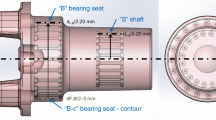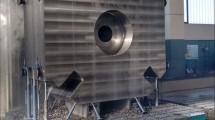Abstract
Cast iron probably represents one of the most widely utilized constructive materials in our modern industrial world. This is due not only to the excellent mechanical and tribological properties, but also to a certain flexibility of the same. In fact, it can be produced in various types of metal alloy, which differ significantly in properties: from the poorly performing, but economical white cast iron, to the excellent resistant nodular cast iron. In this study, several preliminary results on the experimental measurement of fatigue resistance are proposed for two distinct families of cast iron, the ductile and the vermicular. While the former is well known, with a great variety of applications, vermicular cast iron is almost unfamiliar at the moment in terms of utilization, despite different potentials. This experiment compares the results of the Rotating Bending Fatigue test for cast iron specimens made under foundry process conditions as identical as possible in the way to reduce bias.
Access provided by Autonomous University of Puebla. Download conference paper PDF
Similar content being viewed by others
Keywords
1 Introduction
1.1 Spheroidal Cast Iron
The spheroidal cast iron (SGI), also known as ductile cast iron, is a cast alloy in which graphite, instead of in the form of lamellae, occurs in nodules in the shape of spheroids. The nodules are located in a metal matrix whose structure is a function of the chemical composition of the specific type of cast iron, of the cooling rate at the time of solidification and of any subsequent heat treatments [1, 2].
The spheroidal form of graphite produces a lower concentration of tension than the lamellar one; moreover, the spherical shape is the one that, with the same volume, has the smallest surface and the matrix is therefore less damaged, thus being able to better exploit its characteristics [3, 4].
Furthermore, in spheroidal cast iron, graphite nodules exert a stopping action for cracks, unlike lamellar graphite which offers a preferential way for their propagation. Spheroidal cast iron shows a notable improvement of all mechanical characteristics including the fatigue behavior [5,6,7].
1.2 Spheroidal Cast Production
Spheroidal cast iron is produced starting from a base cast iron and adding appropriate magnesium alloys that can favor the spheroidization of the cast iron (Fig. 4.1). Concentrations of chemical elements in molten alloys and process temperatures must be kept under strict control to ensure the correct formation of the microstructure [1, 3].
This accuracy in process and products is important in general for every cast iron, but even more relevant in the case of SGI. For example, a variation of only 2% of Si leads to an increase in the temperature of the stable eutectic and the lowering of the metastable one from the initial 6 to 40 °C with effects on spheroidization. Each modification in the structure affects the main characteristics of the alloy, but even more so for those properties that are intrinsically linked to the benefits offered by the spheroids, such as fatigue strength [2,3,4, 6, 8].
Thus, the study of those properties such as fatigue strength, linked to the propagation of cracks across the microstructures, deformed by nodules, becomes even more fundamental in terms of appearance such as, for example, tensile strength.
1.3 Aim and Scope
In line with what just said, this article describes an experimental study aimed at measuring the fatigue strength of a ductile iron produced in a cupola furnace at the SCM Foundry, Italy. This work is part of a broader investigation that led the research team to study some of the main mechanical [9, 10] and tribological properties [11] of nodular cast iron under carefully controlled process conditions, including the development of advanced techniques for data interpretation based on machine learning [12,13,14]. In particular, regarding the fatigue resistance, a characterization study of SGI is already available, but based on a push–pull load configuration [15]. The present work complements these results by adopting a rotating load configuration.
2 Materials and Methods
2.1 Samples Production
The fatigue behavior of SGI was investigated by a four-point rotating bending test in accordance with ISO 1143 [16] and ISO 12107 [17]. Standardized specimens were extracted from a metallic block and shaped by tool machining (Fig. 4.2).
Table 4.1 reported the chemical composition (in % of weight) of ductile (SGI) and vermicular (CGI) irons.
2.2 Fatigue Life
ASTM considers the ‘fatigue life’ as the number of stress cycles applied before a failure in the specimen occurs. For some materials, such as cast iron, there is a stress value below which the material will not fail regardless of the number of cycles.
The standards also define, as known, different methods for determining the fatigue behavior of a material, including the identification of the fatigue strength.
In this investigation, fatigue tests were carried out by applying a sinusoidal stress. The tests were performed at different stress levels (S) by recording at how many cycles the failure occurs (N). Each completed test leads to a known failure time (F). In the absence of failure, the test can be terminated without this information. Anyway, for these samples that have finished early (run-out), the data (R) can be also considered for evaluation and analyzed using typical statistical techniques.
However, the results may depend on the number of specimens used and on the sequel of loads applied to these specimens.
For this reason, special attention was paid to applying the regulations in the present study. Specifically, the fatigue tests were implemented with a sequence of loads defined using the modified staircase method in accordance with the ISO 12107 standard. This method aims to reduce the number of tests and samples.
In brief, it is based on the procedure to decrease the test stress (σ0) when a previous test has led to failure and increase it if not. The step of change of load (d) is the same, both in the case of increase or decrease, possibly equal to the uncertainty of this kind of measure. The procedure is repeated until all samples are tested.
In the present case, from the knowledge of the general properties of SGI and assumptions of similar investigation, it was decided to use an initial test stress of σ0 = 215 MPa, equivalent to 1/3 (33%) of a characteristic value of the Ultimate Tensile Stress (UTS) of SGI. As modification value, d = 10 MPa was chosen. Test limit was set to 107 cycles (run-out). These parameters are also summarized in Table 4.2.
3 Results and Discussion
3.1 Experimental Data
N. 15 samples were tested by rotating bending fatigue tests considering a stress level between 205 and 245 MPa. N, 7 of them failed (‘F’) while N. 8 samples run out to 107 cycles (‘R’). Table 4.3 reports the experimental data.
The same table also exhibits details regarding the test progression. For instance, the first test took place at 215 MPa of load (σ0) leading to a fail after 3.0⋅106 cycles. Then a 10 MPa reduction in the stress level was implemented and new test showed no fail up to 10⋅106. Thus, the stress level was increased again for additional 10 MPa, but, also in this case, no failure occurred. Then, stress level was increased once again, for additional 10 MPa. And so on.
Figure 4.3 graphically shows the same experimental values. In this case, samples are not reported in the testing order but respect to the level of stress. The filled circles, as symbols, indicate failures while other symbols indicate run-outs. Data show, for instance, that the run-outs are mainly concentrated at lower load values.
3.2 Fatigue Limit
Fatigue properties were estimated considering the probabilities of failure of 10% and confidence levels of 90% in accordance with ISO 12107, as shown in Table 4.4. With the scope it was necessary to evaluate the following parameters:
As a consequence, the fatigue limit at 50% probability of failure can be determined as:
4 Conclusions
This experimental study provides results regarding the measure of fatigue resistance for ductile cast iron (SGI). Several standards were followed as a reference in the testing and data analysis. Specifically, using 4-points rotating bending fatigue test, up to 107 cycles, and 15 specimens, it detects 227 MPa as fatigue limit. This value, much lower than other material resistances (e.g., ultimate tensile stress) makes evident the attention of designers in using cast iron in the presence of high number of load cycles.
References
Minkoff I (1983) The physical metallurgy of cast iron. Wiley, New York
ASM International (1996) Specialty handbook: cast irons, pp 33–267
Angus HT (2013) Cast iron: physical and engineering properties. Elsevier, London
Elliott R (1988) Cast iron technology. Butterworth-Heinemann, London
Emerson PJ, Simmons W (1976) Final report on the evaluation of the graphite form in ferritic ductile iron by ultrasonic and sonic testing, and the effect of graphite form on mechanical properties. AFS Trans 76(26):109–128
Fuller AG, Emerson PJ, Sergeant GF (1980) A report on the effect upon mechanical properties of variation in graphite form in irons having varying amounts of ferrite and pearlite in the matrix structure and the use of nondestructive tests in the assessments of mechanical properties of such irons. AFS Trans 80(9):21–50
Radiša R, Dučić N, Manasijević S, Marković N, Ćojbašić Ž (2017) Casting improvement based on metaheuristic optimization and numerical simulation. Facta Univ Ser Mech Eng 15(3):397–411
Fragassa C (2017) Material selection in machine design: the change of cast iron for improving the high-quality in woodworking. Proc Inst Mech Eng C J Mech Eng Sci 231(1):18–30
Radovic N, Morri A, Fragassa C (2012) A study on the tensile behavior of spheroidal and compacted graphite cast irons based on microstructural analysis. In: 29th Danubia Adria symposium on experimental solid mechanics, Belgrade, Serbia, pp. 164–170
Fragassa C, Radovic N, Pavlovic A, Minak G (2016) Comparison of mechanical properties in compacted and spheroidal graphite irons. Tribol Ind 38(1):49–59
Fragassa C, Minak G, Pavlovic A (2016) Tribological aspects of cast iron investigated via fracture toughness. Tribol Ind 38(1):1–10
Fragassa C, Babic M, Bergmann CP, Minak G (2019) Predicting the tensile behaviour of cast alloys by a pattern recognition analysis on experimental data. Metals 9(557):1–21. https://doi.org/10.3390/met9050557
Fragassa C, Babic M, Pavlovic A, do Santos ED (2020) Machine learning approaches to predict the hardness of cast iron. Tribol Ind 42(1):1–9
Babic M, Fragassa C, Lesiuk G, Marinkovic D (2020) New method for complexity determination by using fractals and its applications in material surface characteristic. Int J Qual Res 14(3):705–716
Fragassa C, Zigulic R, Pavlovic A (2016) Push-pull fatigue test on ductile and vermicular cast irons. Eng Rev 36(3):269–280
ISO 1143 (2010) Metallic materials—rotating bar bending fatigue testing
ISO 12107 (2003) Metallic materials—Fatigue testing—Statistical planning and analysis data
Author information
Authors and Affiliations
Corresponding author
Editor information
Editors and Affiliations
Rights and permissions
Copyright information
© 2022 The Author(s), under exclusive license to Springer Nature Switzerland AG
About this paper
Cite this paper
Radovic, N., Marinkovic, D., Miloradovic, N. (2022). Rotating Bending Fatigue of Spheroidal Cast Irons. In: Lesiuk, G., Szata, M., Blazejewski, W., Jesus, A.M.d., Correia, J.A. (eds) Structural Integrity and Fatigue Failure Analysis. VCMF 2020. Structural Integrity, vol 25. Springer, Cham. https://doi.org/10.1007/978-3-030-91847-7_4
Download citation
DOI: https://doi.org/10.1007/978-3-030-91847-7_4
Published:
Publisher Name: Springer, Cham
Print ISBN: 978-3-030-91846-0
Online ISBN: 978-3-030-91847-7
eBook Packages: EngineeringEngineering (R0)







